Most recently updated July 7th, 2023
Estimated Reading Time: 17 minutes
It’s been a while since I’ve written about anything asthma-related.
Of course, those of you living with this chronic illness already know that for us, everything is asthma related 😉
That’s kind-of what I’d like to talk about today…

One reason I started this blog was to share my ongoing quest to enjoy a “wheeze free” life – in hopes that my experience could help someone else.
I’ve written posts about what kind of diet and supplements helped, what kind of exercises worked, the latest medications, how to clean the air inside your home – and much more.
But one thing I’ve never written about is how chronic asthma makes you feel.
Some of my posts contain affiliate links. If you make a purchase through an affiliate link, I will receive a small payment at no additional cost to you. As an Amazon Associate, and other marketing affiliations, I earn from qualifying purchases. See full Disclosure page here.
As usual, for inspiration I’m sharing photos of beautiful places I’ve been able to visit and hike, without any trouble breathing!
And lest we forget, every case of asthma is different, and you shouldn’t just take my word for it:
NOTE: I am not a medical practitioner, and speak only from my own personal experience and what I’ve found in research. As always, consult your doctor before making substantial changes in your medications, exercise, or eating habits.

Living Defensively
Asthma affects more than just our lungs – it affects how we approach everything we do, every day.
Effects on Your Day-to-Day Life
Living with asthma means every time you leave the house, you’ve got a survival checklist like you’re climbing Everest.
Inhalers, pills, epi-pen, water, phone numbers, insurance card…check!!
So there’s that.
And let’s just assume you already know your triggers and are doing your best to avoid them in your home and elsewhere.

Let’s further assume that you’re eating and exercising in a way to minimize your asthma, and that you’re also taking medications and supplements to help.
You might be thinking – okay I’m doing all of this. What else is there?
Once you’ve got all of the basics covered, the main thing you need to do is protect yourself from other people. That’s right – other people.
Even well-meaning people can put you in risky situations – because they don’t know what can hurt you, or how bad it can get.
And if you’re usually asymptomatic (because you’re taking care of yourself) they may not really believe you when you tell them, either.
The best thing – and the most difficult thing – is to know when to leave an event, or decline an invitation.

When I was a child, my Mom would look at me for signs of asthma trouble, and sometimes make me stop playing, or take some medicine.
Of course this wasn’t fun for me and I would try to fake normal breathing – I wanted to keep playing! – but Mom always knew when it was time to stop.
As an adult, I would sometimes use my own child as an excuse for leaving an event when I was getting sick, because it’s an easier explanation than asthma when your friends can’t tell yet that anything is wrong.
So, basically for me there’s always this tug-of-war between wanting not to be left out and knowing you could end up in real trouble.
When you have to be well enough to get a child safely home, it’s easier to decide to miss out on things – even if others assume you’re being over-protective or anti-social.
It’s harder to make that same choice when you’re only putting yourself at risk.

A recent example of a tough decision between what I wanted to do and what I knew was the smart choice happened this past Summer.
I had planned to spend a week hiking with friends in Glacier National Park, but I had to cancel because Glacier and the areas around it were all covered with wildfires.
Other people could tolerate it, but the smoky, sooty air was a big risk for me. So I didn’t go, and it made me sad.
But for my sake and everyone else’s, I decided to wait for another time when less of the forest was on fire 🙂
I don’t ever want to get sick and spoil other people’s fun, or attract attention to myself because of my asthma.

Asthma is Painful
Breathing is just one of those things you take for granted – like blinking your eyes. It just happens.
Until you’re having severe asthma symptoms, and you have to think about every inhale or exhale.

Like most health conditions, asthma severity runs along a spectrum.
Some people have asthma where they experience minor symptoms every once in a while, and barely ever need any medication.
But even mild asthma can make people panicky when they can’t catch their breath.
This level of severity is usually relieved quickly with a puff on an inhaler, stopping the activity that’s causing it, or a cup of coffee.
Others have asthma that is basically always at DEFCON 2, they’re constantly puffing on an inhaler – and they’re still gasping for breath!
When this happens it can be both painful and terrifying, especially for a child or someone who hasn’t experienced this level of severity before.
This kind of asthma could easily escalate into a terrifying attack that could be life-threatening.
Sometimes these severe attacks go on for days at a time, so severe that you can’t lie down to sleep, can’t eat, can’t do anything but focus all of your strength on taking the next breath.

During these kinds of attacks, your lungs hurt and so do the muscles in your chest, back and abdomen from working so hard without a break.
You also usually have a monstrous headache from elevated blood pressure.
Once a severe attack is over, your breathing will be normal, but your chest, back and abdomen muscles may be sore and stiff.
This is no different than the pain and soreness you feel after a good, strong workout.
Like pain and sore muscles from any other workout, this will go away in a day or two.
Making the Right Decision
As a life-long asthmatic, every time my asthma flared up, my lungs and muscles were in some degree of pain.
The problem is, when you’re in constant discomfort or pain for an extended period of time, you begin to acclimate to it, and possibly ignore it for too long.
Part of the danger with asthma is that when it’s severe, you’re getting significantly less oxygen in your bloodstream – and of course, that means less oxygen to your brain, too.
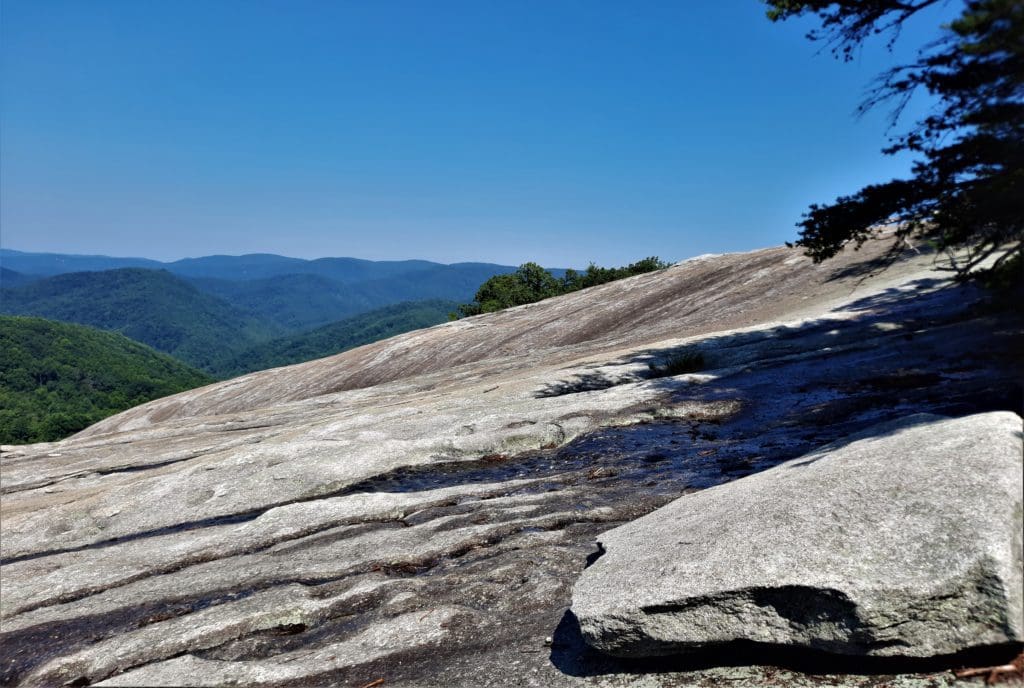
So you can’t always be sure you’re making the best decisions – like when you should to go to the hospital.
The Cure is Painful
If you do finally go to the hospital, and you’re admitted – that’s an opportunity for a whole new type of pain.
On the less-painful end, a simple three-injection cocktail of epinephrine and long-lasting susphrine was the usual first-attempt treatment when I was growing up.
This treatment could be administered at your local doctor’s office or at the Emergency Room.

Bonus of this treatment is that you could usually go home within an hour or two at most.
Last ditch effort is when they intubate you – meaning they stick a tube down your throat so a ventilator can take over your breathing.
This is uncomfortable at the least, and you likely will be a guest in the ICU for a couple of days.
The worst part is when they remove the ventilator. The doctor has you exhale, and while you’re doing that, they just yank the ventilator and hose out.

It hurts more coming out the longer it’s been in there, because your body has started growing around it.
So there’s blood and other unpleasantness…..
I believe the best thing you can do for your asthma and your health in general, is simply to stay well enough to never have to go to the hospital.
Hopefully, if you’re an asthmatic, this description of the physical feelings associated with asthma attacks will make you feel more understood.
Or, if you are a caregiver for an asthmatic, help you to understand what they’re going through.
Before we dig in to the “mental health” section of this post:
It’s important to note that for the first half of the 20th century, Western medicine – even as recently as my childhood – considered asthma to be psychosomatic, and would refuse treatment or even (in the early days) commit asthmatics to mental institutions.
Fortunately, there’s been a lot of progress since then in understanding the different causes and types of asthma.
But I haven’t forgiven my childhood doctors. Just sayin’.
All the Feels
Even with all of the maintenance and rescue drugs available today, asthma attacks are an unpredictable event for many people.
And sometimes despite our best efforts asthma happens when we don’t expect it – like the Spanish Inquisition 😉
For all people, unpredictable events are usually more stressful than ones you can plan and prepare for.
A study from Johns Hopkins Advanced Studies in Medicine found that “asthma impairs patients’ well-being and can significantly interfere with the ability to undertake normal daily activities.”
(Asthmatics and their caregivers knew this already. )
In 2002 in the United States, adults missed 11.8 million workdays and children aged 5-17 missed 14.7 million school days because of their asthma.
Many parents also limit their children’s physical activities because they’re worried about their safety – like my Mom did.
Limiting these sorts of activities can isolate them from other kids and make them feel alone.
I did feel separate from the other children, not necessarily because of the asthma, but because I had to be very responsible at a young age, and make good decisions so I wouldn’t get sick.
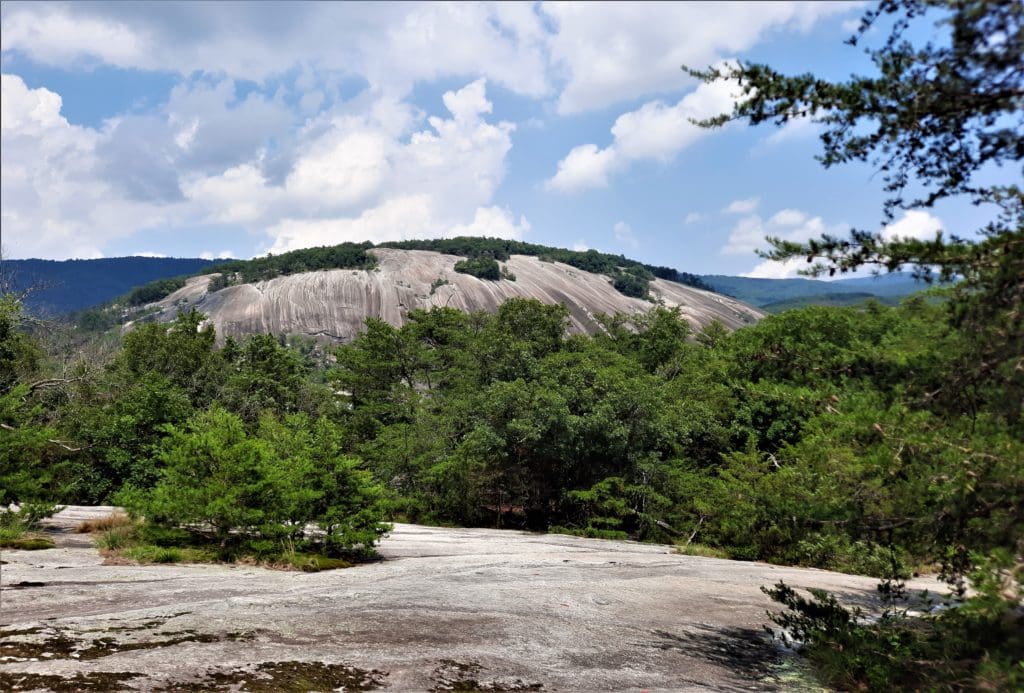
Let’s Get Sciencey
According to one Canadian study, those with asthma have a doubled risk of having anxiety or depression.
For years, doctors have recognized that emotional stress and depression can be linked to asthma.
Researchers exploring the bi-directional connection between asthma and mental health found that:
-
-
- 48% of the time asthma caused anxiety/depression, and
- 52% of the time anxiety/depression caused the asthma.
-
This again raises the question: Is the asthma causing the depression or is the depression causing the asthma?
In my experience the inability to breathe tends to make me anxious – and also a lifetime of dealing with the inability to breathe can be depressing.
These studies didn’t identify the type of asthma, but allergic asthma (caused by an external trigger) was likely not included, as this type of reaction is almost always a biological (rather than an emotional) response.

For instance, you can have a severe asthmatic reaction to a bee sting or another allergen.
This may make the person having the attack anxious, but the anxiety isn’t the root cause of the asthma.
My mother used to tell me, “Don’t cry – it just makes the asthma worse.” It turns out she was right!
The latest research seems to support the idea that existing asthma may be made worse by some of the physical changes caused by an emotional response.

Research found these links between sadness (depression) and symptoms of asthma:
-
-
- Acute sadness produces bronchoconstriction in asthmatic children, along with vagus nerve activation.
- Many people with depression show activation of the vagal system, and vagal stimulation causes bronchoconstriction.
- Also, stress and chronic depression are accompanied by general inflammation, which makes asthma worse.
- Severe asthma can lead to oxygen desaturation and fatigue, which is also a symptom of depression.
-
A recent genetic investigation also found evidence for shared genetic influences between asthma and depression in controlling the inflammatory pathways.

Asthma and PTSD
There are more than 4,000 deaths each year that can be directly attributed to asthma, and asthma can be considered a contributing factor for an additional 7,000 deaths per year.
In fact, asthma accounts for 25% of all emergency room visits in the United States per year and is the third-ranking cause of hospitalization for children.
Life-threatening asthma attacks definitely meet criteria for a traumatic event according to the 4th edition of the Diagnostic and Statistical Manual of Mental Disorders:
-
-
- First, asthma attacks may be life-threatening or cause physical harm.
- Also, the unexpected nature of an asthma attack, as well as the physical symptoms that accompany an asthma attack, may bring about feelings of fear, helpless, and horror.
-
Given this, asthma could definitely lead to the development of PTSD symptoms.

Medical Illness as a Trigger
Scholars have long known that people who live with chronic illness are at a greater risk of experiencing PTSD-like symptoms.
The trigger for these symptoms is not a one-time event that occurred in the past, it’s an ongoing threat to safety.
Most traumas come from the external environment: a natural disaster, an attacker, a war.
But in the case of chronic illness, the trauma comes from within.
Our bodies are the source of danger, and that makes it feel like no place is safe.
Researchers have proposed a model of PTSD that accounts for this difference, called the Enduring Somatic Threat (“EST”) model of PTSD.

What Are the Symptoms of PTSD?
Re-experiencing – is exactly what it sounds like: a mental re-living of the trauma. It can include intrusive thoughts, flashbacks and nightmares.
For many people living with chronic illness, re-experiencing is particularly alive during interactions with doctors and hospitals. Even just driving by the hospital may cause panic.
Hyperarousal – symptoms for chronically ill people often manifest as an intense awareness of bodily sensations, and some with these symptoms are dismissed as hypochondriacs. Difficulty sleeping and irritability are also symptoms of PTSD hyperarousal.
Avoidance – occurs as a way of managing the intense anxiety that accompanies re-experiencing and hyperarousal. People with this symptom find ways to avoid the hospital, doctors, and anything that has to do with the illness.
Who’s at Risk?
-
- In a study, 20% of adolescents who had a life-threatening asthma episode could be diagnosed with PTSD.
- In addition, almost 30% of the parents of adolescents who had a life-threatening asthma episode met criteria for PTSD.
So, both asthmatics who’ve had life-threatening asthma and their parents are at risk for developing illness-related PTSD.
It’s likely I have PTSD, but I prefer to think of it as “learning from experience” 😉

How To Treat Illness-Related PTSD
The EST model of PTSD recognizes that chronic illness presents an ongoing rather than a one-time threat. The dangers that we’ve experienced in the past due to our illness likely will happen again.
Knowing this, treatment should focus heavily on developing coping skills.
Again, although I’m not one to share feelings, a good psychotherapist can help you build coping strategies that will help you feel safer and more in control.
Some of the strategies could include self-talk, support networks, and devising multi-step plans to see you through medical crises.

Researchers in this field have also recognized something called “post-traumatic growth”.
That is, people can and do use adverse events such as chronic illness to make positive changes in themselves, their relationships, and their worldview.
One great example of post-traumatic growth is Teddy Roosevelt, our 26th President.
Famous Asthmatic: Teddy Roosevelt

The early life of Theodore Roosevelt was shaped in large part by his severe asthma.
In fact, some could say his experience with asthma played a big part in shaping the man he eventually became.
Many of us know of Roosevelt as a conservationist, and the 26th President of the United States, but let’s learn more about Teddy Roosevelt, asthmatic.
Roosevelt’s Early Struggle with Asthma
Theodore Roosevelt was born in October 1858 in New York City, to a well-known and distinguished family. He was the oldest son of four children.
A sickly child with debilitating asthma, he was often unable to participate in many childhood activities like playing outside and going to school.

Doctors didn’t understand the disease very well at the time, and Teddy was prescribed remedies like:
-
-
- Going on vacation to the coast,
- Smoking cigars, and
- Drinking coffee and whiskey.
-
Put all together, this sounds like Spring Break 😉
Teddy tried all of these remedies, but (not surprisingly) they didn’t cure his asthma – but hopefully he had a good time trying.
Exercise and a Strong Body
When Teddy was twelve years old, his father lectured him on the importance of developing the body in order to completely develop the mind.
Teddy took this advice to heart and his father built him a home gym.
He lifted weights, did gymnastics, and also rode horseback, swam, hiked, wrestled, boxed, and learned judo.
Eventually, as his body became strong, his asthma disappeared, and Teddy went on to Harvard University and to lead a full and adventurous life, both personally and in politics.

Exercise and Asthma
There are two sides to the relationship between exercise and asthma.
Exercise can actually induce asthma attacks, and there’s even a type of asthma called “exercise-induced asthma”.
Sometimes people with this type of asthma don’t experience asthma for any other reason.
Exercise Induced Asthma
Exercise-induced asthma usually happens because of how your breathing changes when you exercise.
Normally, we breathe through our noses. But during exercise, we usually breathe more through our mouths.

When breathing through your nose, inhaled air gets warmed by blood vessels in your nose.
When breathing through your mouth, cooler, drier air hits the lungs.
Colder air in the lungs can trigger an attack.
I solve this by wearing a scarf or buff over my face outdoors in colder weather.
The positive relationship between asthma and exercise, as in the case of Teddy Roosevelt, is that exercise can greatly reduce the incidence of asthma attacks.
Exercise helps increase lung capacity, which goes a very long way in helping asthma sufferers find relief from symptoms and attacks.
I’ve been a long-time believer in exercise to help not only ward off attacks, but also to help you be strong enough to fight if you do have one.
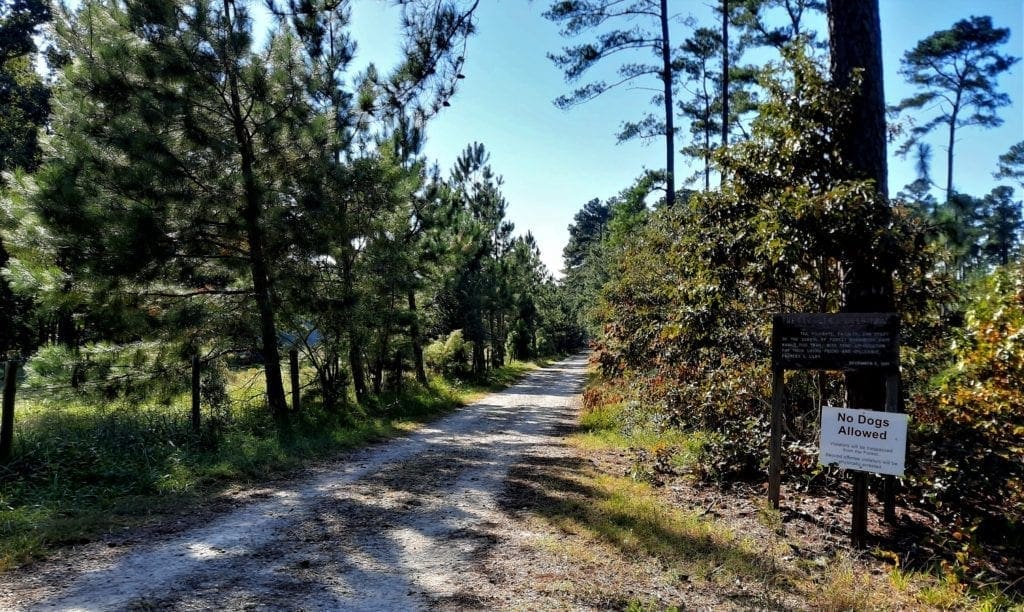
Chronic Illness and Mental Health
Chronic diseases are defined as conditions that last a year or more and require ongoing medical care or limit activities of daily living or both.
Any health condition that causes widespread inflammation may raise the risk of depression because depression has been associated with inflammation in the brain.
Chronic illness may also affect mental health because of increased stress.
There are many possible stressors and many common emotions associated with physical disease – including limitations on activity.
Pandemic and Mental Health
Fear of COVID-19 and/or mandated limitations on activities – and also long-term loss of employment or income – would certainly cause chronic anxiety and stress, and affect your mental health.
In this situation, both children and adults have experienced a mix of emotions – – the greatest of which is ongoing fear.

Impact of Chronic Fear
The feeling that an asthma attack can happen at any time can make people with asthma feel like they’re always in danger. Similarly, research shows that fear of catching COVID-19 has had the same effect on the most fearful.
Living under constant threat has serious health consequences:
-
-
- Physical health. Fear weakens our immune system and can cause cardiovascular damage, gastrointestinal problems, and decreased fertility. It can lead to accelerated ageing and even premature death.
- Memory. Fear can impair formation of long-term memories and cause damage to certain parts of the brain. This can make a person anxious most of the time. To someone in chronic fear, the world looks scary and their memories confirm that.
- Brain processing and reactivity. Fear can interrupt brain processes that allow us to regulate emotions, read non-verbal cues, reflect before acting, and act ethically. This makes us susceptible to intense emotions and impulsive reactions – which can can leave us unable to act appropriately.
- Mental health. Other consequences of long-term fear include fatigue, clinical depression, and PSTD.
-
Sadly, the impact of chronic fear – especially the impact to your immune system – can make you more vulnerable to the illness that you fear.
Since I’ve been under a much greater threat of hospitalization or death my whole life (from severe asthma) than I’ve been from COVID-19, I haven’t had the same level of fear as some of my younger, healthy friends.

Hopefully, as time goes on, people will become less fearful and go back to living healthier lives and be less vulnerable to disease.
“That which does not kill us makes us stronger.”
This famous quote from nineteenth-century German philosopher Friedrich Nietzsche was likely not referring to struggles in living with asthma or even in battling an illness like COVID-19, but more generally to the hardships everyone faces and hopefully overcome in life.
The idea is that by going through difficult experiences, people build up their strength for the next, possibly more painful, thing that could happen.
Nietzsche probably wasn’t talking about acquiring natural immunity to disease, but I think it’s applicable, for sure.
What is natural immunity?
Natural immunity is the antibody protection your body creates against a specific germ once you’ve been infected with it. (For example, people who have had the measles are not likely to get it again.)
As part of the immune response, when your cells “remember” a particular germ they release special proteins called antibodies into your blood stream to stop it.
In their recent study the CDC has concluded that “surviving a previous infection protected against a reinfection and related hospitalization…” for COVID-19, as it does for many known viral diseases, like polio and measles.
That said, there is no such thing as natural immunity – or a vaccine – for asthma. There’s also no cure.
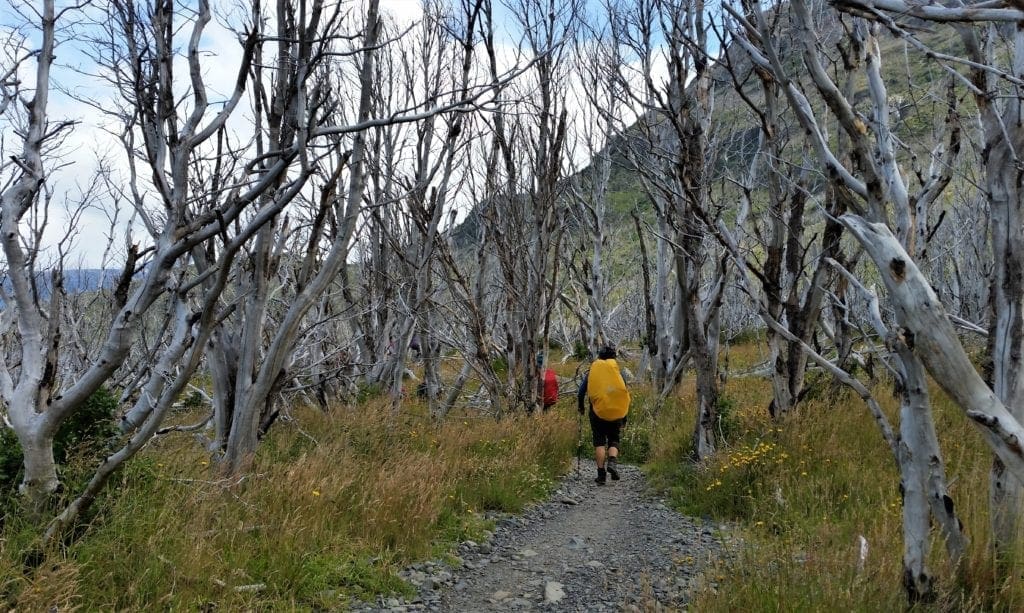
What Can You Do?
After reading all of this, you may be feeling overwhelmed or depressed, thinking there’s not much you can do to fight this disease for yourself or your kids – but don’t be!
We know much more now than ever before about asthma – and no one will lock you away in a mental asylum for wheezing. Probably 😉
You’ve got all of these tools at your disposal:
Exercise – Look what Teddy Roosevelt was able to do, just by exercising his lungs! Read more about how you can hike with asthma.
Diet – Eating a good healthy diet is always a good idea. Learn about a specific diet for asthma that will help fight inflammation and mucous.
Supplements – People have been using herbs to fight illness for 1000s of years! Learn about natural supplements that could help with your breathing.
Clean Indoor Air – These days there are lots of ways to keep your allergens out of your home. Read more about it here.
Sunshine and Fresh Air – Just getting outdoors in the sunshine boosts for Vitamin D and immune system.
Medicine – Whether you’ve got mild or severe asthma, there’s medicine that can help you. Read more about the latest treatments available.
Positive Outlook – Even if your family and friends don’t fully understand, they always want the best for you. And if you need to talk it out, there are many good counselors that can help.
Be Your Own Advocate – This may be the most important thing. No one knows your own body like you do, and you are in charge of it.
So whether you’re speaking with your doctor, your counselor, or friends and family, ask questions and speak up for yourself!
As with most chronic diseases, you get stronger by continuing to fight your asthma every day through good lifestyle and medical choices for your individual situation.

I’ve included links to sources and references throughout this post, but here are few more if you want them!
REFERENCES:
REFERENCE: https://asthma.net/living/mental-health
REFERENCE: https://www.knowyourasthma.com/what-can-you-do-for-chronic-asthma/
REFERENCE: https://www.achooallergy.com/blog/learning/famous-asthma-sufferer-teddy-roosevelt/
REFERENCE: https://www.ncbi.nlm.nih.gov/pmc/articles/PMC7361582/

I hope this information about how asthma and other chronic illness can affect mental health helps you in your fight against asthma and maintaining your overall health!
If you’re battling asthma and allergies, you might be interested in these other posts:
How Asthma and Allergies Change Over Time
What’s the Best Medicine for Your Asthma?
Asthma and COVID-19: Are You at Higher Risk?
Clean Your Indoor Air With Houseplants!
Fight Asthma with Vitamins and Supplements
Eat to Breathe Easier – the Best Food for Asthma
Hiking With Asthma! A 3-Step Plan for Success
If you have a question, drop me an email and I’ll reply as soon as I can. Thanks for stopping by – see you next time! LJ
To Get New Idratherwalk Posts
sent directly to your inbox (how convenient!) Click this Button
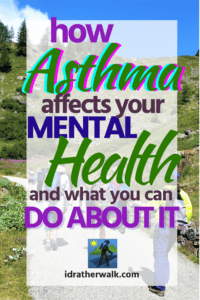

LJ has spent much of her free time as a single Mom – and now as an empty-nester – hiking in the US and around the world. She shares lessons learned from adventures both local and in exotic locations, and tips on how to be active with asthma, plus travel, gear, and hike planning advice for parents hiking with kids and beginners of all ages. Read more on the About page.

